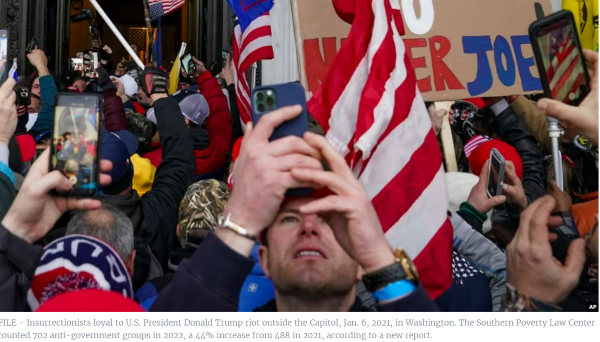Report: Even as Militias Disbanded, Anti-Government Groups Surged in US

The number of anti-government extremist organizations in the U.S. surged last year, even as some militias disbanded and hate groups declined, according to a new report released Tuesday by the Southern Poverty Law Center.
The SPLC counted 702 anti-government groups in 2022, a 44% increase from 488 in 2021. This was the highest number since 2015.
The spike was mainly fueled by SPLC’s designation of the conservative parents’ rights group Moms for Liberty and 11 other “anti-student inclusion groups,” according to Travis McAdam, senior research analyst with SPLC’s Intelligence Project. SPLC says these groups use extremist tactics to oppose diversity and inclusion in schools.
“Their number of chapters grew quickly as they targeted local schools with campaigns of malice and misinformation that degrade the LGBTQ+ community and try to erase the teaching of accurate history,” McAdam said via email.
He added that the SPLC also listed a number of new “sovereign citizen” groups in its tally of anti-government extremist organizations. Sovereign citizens consider themselves exempt from U.S. law.
“The growth in these two sectors of the anti-government movement offset the decrease in militias,” he said.
‘Educating and empowering parents’
On its website, Moms for Liberty says it is “dedicated to fighting for the survival of America by unifying, educating and empowering parents to defend their parental rights at all levels of government.”
Asked about the SPLC designation, Moms for Liberty co-founders Tiffany Justice and Tina Descovich said in a statement emailed to VOA, “Name-calling parents who want to be a part of their child’s education as ‘hate groups’ or ‘bigoted’ just further exposes what this battle is all about: Who fundamentally gets to decide what is taught to our kids in school — parents or government employees? We believe that parental rights do not stop at the classroom door, and no amount of hate from groups like this is going to stop that.”
The surge in the number of anti-government groups came even as militias — the “paramilitary wing of the anti-government movement” as the SPLC refers to them — shrank in number in the wake of the January 6, 2021, attack on the U.S. Capitol. The SPLC identified 61 active militia groups in 2022, down from 92 in 2021.
One of the most prominent anti-government militias, the Oath Keepers, lost many of its local chapters after its leaders were arrested in connection with the January 6 assault.
Last month, Stewart Rhodes, the group’s founder, and a former top lieutenant received 18- and 12-year prison terms respectively for their roles in the attack. Several other Oath Keepers have also been given lengthy prison terms.
The SPLC said the number of Oath Keepers chapters dropped to five in 2022, down from 70 in 2020.
Rachel Carroll Rivas, deputy director of research, reporting and analysis at SPLC’s Intelligence Project, noted that anti-government groups, which view the federal government as tyrannical and illegitimate, tend to grow under Democratic administrations as they rally against their policies.
“This is a trend we’ve seen over time during the Obama years,” Rivas said, referring to former President Barack Obama’s presidency from 2009 to 2017.
The number of hard-right anti-government groups reached a record 1,360 under Obama, then dwindled during Donald Trump’s presidency.
Now, with American’s trust in public institutions near historic lows, experts say anti-government groups are seizing on issues like “woke indoctrination” in workplaces and schools to fuel their agenda.
Brian Levin, executive director of the Center for the Study of Hate and Extremism at California State University, San Bernardino, said the SPLC report’s most “disturbing finding” was the “continued vibrancy of antigovernment groups.”
“In a highly charged and politically divided atmosphere, anti-government vitriol and conspiracies are an easier initial ‘gateway’ sell than the more blatant xenophobic and racist propaganda of adjacent extremists,” Levin said.
The number of hate groups, which attack entire classes of people such as immigrants and LGBTQ people, dropped to 523 last year from 733 in 2021. The number has fallen significantly since peaking at more than 1,000 in 2018.
But SPLC officials said this does not mean there was a decrease in hate and extremism.
The line between hard-right extremism and mainstream politics has become increasingly blurred, they said, as hate groups have gone mainstream in a post-January 6 shift in strategy.
“Main Street America is now seeing organizing locally to pursue a hateful agenda in public view, including the targeting of community safe havens like schools and houses of worship,” Margaret Huang, president and CEO of SPLC, said during a press call.
The SPLC has been publishing its annual hate report since 1990.
In recent years, some conservative groups have criticized the SPLC, saying it unfairly labeled them as extremist groups.
Huang defended SPLC’s “rigorous” research methodology, saying the group “carefully labels an organization or a group of individuals, as either a hate group or an anti-government extremist group, based on specific criteria and clear evidence of action during the calendar year of 2022.”

